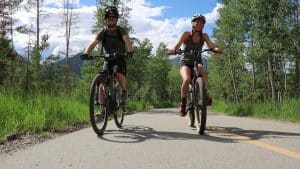Chasing the dream
summit daily news

ALL |
Once upon a time, Forest Carey was more of a can’t-miss kid than Bode Miller.
He grew up in Maine, started skiing as soon as he could walk, and his career had all the makings of great. If anyone was going to achieve the ski racer’s dream ” international renown, World Cup stardom, an Olympic gold medal ” it was going to be him.
Carey made the U.S. Ski Team at 16, the spring of his sophomore year in high school at Maine’s Carrabassett Valley Academy (CVA). Miller, a year younger than Carey and his classmate at CVA, used to borrow Carey’s skis when Forest would let him.
At that point, Carey had what Bode ” and the rest of the nation’s teen ski racers ” wanted: a career on the fast track to the planet’s top level.
Yet two years ago, at age 26, Carey was not on the World Cup, or even the U.S. team. Instead, he was fighting for his racing identity on the NorAm Tour, at mid-level races in Europe, basically anywhere he could get on a decent FIS start list.
His can’t-miss career had been derailed by injuries, mainly to his knee. By the time he was 18, he was getting regular cortisone shots and routinely having his knee drained of fluid. Between 17 and 20, Carey had four major surgeries.
He spent three years on the national team, then another three skiing at Middlebury College in Vermont, but he hadn’t come close to fulfilling his promise. After school, exhausted and drained from chasing the dream, he let it go. He moved to San Francisco and became the athletic director at a boys and girls club.
Then something happened. A doctor in Mexico gave Carey new hope with his knee. Suddenly, his dream was alive again. And like he had for so many years before giving it up, he embraced it.
He moved back to Maine, took a job as an ability coach at CVA. His hopes there were twofold: make his pupils better, while trying to get back on the U.S. Ski Team himself.
Carey did well, finishing in the top 10 at some NorAm races. He still believed, with every ounce of his being, that he could reach his original goals.
Alas, a job offer from Middlebury to be the Panthers’ head alpine coach came along, and he couldn’t refuse it. So, at 27, after chasing the dream for more than two decades, he finally gave it up once and for all.
Asked now what that was like, the first words out of Carey’s mouth are “Oh, dude …” Then he trails off.
As Carey’s case illustrates, the ski racer’s dream is possessing. Chasing it for years upon years can be draining, but it pales in comparison to giving up the pursuit.
Plenty of skiers in Summit County can attest to that. Unlike baseball or football, there is no annual draft to separate those who can go on from those who can’t. In skiing, as long as you have an FIS license and maintain a points standing, you can continue racing as long as you like.
In other words, it is up to each individual to decide when the time has come to move on.
The typical options are these: Either you give up full-time training after high school and go to college, or you put off school and continue skiing with a club as a “postgraduate,” or “PG.”
If you choose the latter, you travel around the world and try to improve your FIS points enough so that the U.S. Ski Team coaches take notice. If things go well, you get your points so low (usually the teens or low 20s) that you earn a spot on the national team ” or, in the racer’s lingo, “the ski team.” This is the first step to achieving the dream.
Gary Beresford, a 19-year-old racer who lives in Dillon, graduated from Summit High in 2004. He opted not to attend college this year, but instead to train full time with Quantum Sports Club’s “elite” program.
A number of kids his age or younger compete on the national team, and with the 62 FIS points he boasts in slalom his best in any event, you could argue Beresford is wasting his time. He might be better off spending his time in college, you could say.
Beresford doesn’t believe in that school of thought, at least not now. The dream is still too salient in his everyday life.
“I know I’m skiing faster than the points I have right now,” he said, adding that he doesn’t feel guilty about not going to college. “You sometimes get that feeling, but once I start skiing it goes away. It’s a different life, and it’s what I love, so I don’t feel bad about it.”
John Leffler, the Quantum coach who has run the club’s elite program for five years, said he is “generally offended” by the prevailing notion that says all but the top skiers should abandon full-time training and go to college.
Instead, he said, skiers should pursue their dream until “the passion is not sufficient to overcome the obstacles, or when you have a new passion.”
Leffler believes the eventual determining factor for all racers deciding when to give up the dream is not physical.
“Everybody meets the threshold, where you can’t overcome what’s necessary to compete at that level,” he said. “And it’s totally a mental or spiritual threshold.”
The scholastic route
To be sure, achieving a spot on the national team out of college is possible. At least one or two do it every year. But it’s a rare occurrence.
Amy Beresford, Gary’s sister, is one who hopes to do it. She took a year off after high school to train with Quantum, then enrolled at the University of Colorado in Boulder to ski with the Buffaloes. Things didn’t go as well as she’d hoped, so she went back to Quantum for the 2004-2005 season.
At 22, she has slalom and GS points in the 30s and still thinks she can make the U.S. team.
One of the reasons the dream is still alive, she said, is because “ski racing, more than some other sports, allows for room at the top for a lot of good people.”
Asked how much longer she’ll continue to chase the dream, she said, “I haven’t gotten there yet, so I don’t know how to answer that one.”
It’s not cheap to train as a postgraduate; between coaching, equipment, sumer camps and travel, a year of full-time (16-20 hours per week in the winter) training can cost as much as $20,000. This is perhaps the biggest hurdle, and certainly one of the forces that dictates when racers abandon their goals.
Yet the lingering carrot, that wonderful prize at the end of the long, dark tunnel, is enough to keep the train going.
What’s more, said Carey, now the Middlebury coach, there is something haunting about racing. Something fundamental that fuels the dream from day 1, and makes it a dread to give up.
“It’s f—— fun, man, it’s a rush,” he said. “Every sport has it, but … the feeling of laying it over and arcing is a little bit addicting, you know, holding on for dear life in a super-G going 70.”
Devon O’Neil can be contacted at (970) 668-3998, ext. 231, or at doneil@summitdaily.com.

Support Local Journalism

Support Local Journalism
As a Summit Daily News reader, you make our work possible.
Summit Daily is embarking on a multiyear project to digitize its archives going back to 1989 and make them available to the public in partnership with the Colorado Historic Newspapers Collection. The full project is expected to cost about $165,000. All donations made in 2023 will go directly toward this project.
Every contribution, no matter the size, will make a difference.









